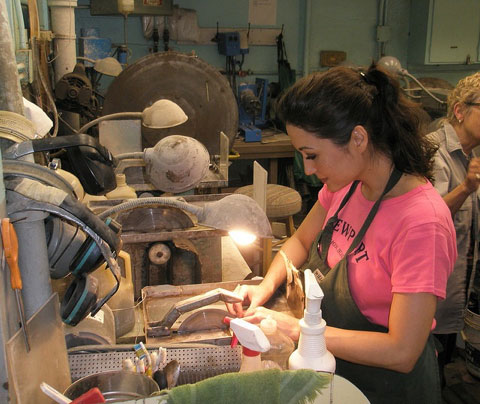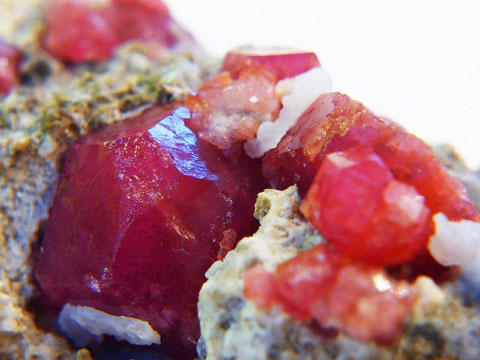An Introduction To Gemology by Donald Clark, CSM IMG
Gemology is the scientific study of gemstones. Although there may be investors and collectors who are only interested in the monetary value of gems, they’ll need a scientific approach when the time comes to distinguish one gemstone from another. Who will they seek out? Gemologists. Reviewing the different types of gemologists and what they do will make a good introduction to gemology, for collectors as well as those curious about careers in gemology.
Jewelers and Goldsmiths
 “Quality Control” by Lars Plougmann
“Quality Control” by Lars Plougmann is licensed under CC By-SA 2.0
Jewelers need to understand gemology to answer their customers’ questions and identify any gems brought to them.
Goldsmiths (and other metalworkers) need specific knowledge about the physical characteristics of gems in order to create appropriate settings. For example, a setting that would be ideal for a diamond could damage an opal, and the amount of pressure used to set the prongs on a garnet could break a tanzanite. Some gems can withstand the heat of repair work involving high temperature soldering and can be left in their settings if precautions are taken. Other gemstones are so heat sensitive they would need to be removed.
Lapidaries
 “Lapidary Lessons” by Naomi King is licensed under CC By 2.0
“Lapidary Lessons” by Naomi King is licensed under CC By 2.0
Lapidaries, or gem cutters, also need special knowledge. Appropriate cutting and polishing techniques vary from gem to gem. What would work well for one gemstone would be a waste of time or even disastrous on another gem. Faceting and gemstone color management go hand in hand. How the rough is oriented can greatly impact the appearance of the finished gem. Cutting style is also a part of color management.
The choice of cut can lighten or darken a gem, which will considerably affect both the appearance and the value of the stone. The shape, number, and location of facets influence the brilliance of the gem. The angles at which the facets are cut must be carefully chosen. All these factors must be considered to minimize the amount of gemstone rough sacrificed to create a beautiful faceted gem.
The scientists
 “Amber” by Upupa4me is licensed under CC By-SA 2.0
“Amber” by Upupa4me is licensed under CC By-SA 2.0
Although scientists with degrees in geology, chemistry, and even physics make up the smallest group of gemologists, they are influential. The systematic measurement and recording of the physical and optical properties used to identify gemstones is a well established but ongoing scientific process. For centuries, the lapidary was in the best position to recognize the differences in gems with similar appearances. The faceting process offered a perspective on gemstones no other gemologist had. Many inclusions, materials trapped inside gemstones, and physical characteristics, such as hardness, were readily apparent when cutting and polishing a gem. Scientists continue to add to this knowledge by developing new testing techniques and researching new gemstones discovered in nature and synthesized in the laboratory.
Amber is well known for its inclusions. It can have materials such as ancient pollen, insects, and other organic debris trapped inside.
Gemstone Identification
 “Garnet” by Andrew Gustar is licensed under CC By-ND 2.0
“Garnet” by Andrew Gustar is licensed under CC By-ND 2.0
Gem identification is the heart of gemology. For example, some rubies and garnets are impossible to distinguish by observation, but their physical properties differ considerably. Ruby and garnet crystallography varies greatly. While the visible shapes of individual stones may vary, the crystal structures of these gems at the atomic level are distinctive. Garnets form in the cubic system. Rubies form in the hexagonal system.
Mineralogical techniques are also used to help identify gemstones. Scratch tests, in which various substances are used to scratch an unknown gem, determine hardness. A gem’s reaction to acid and even heat can yield important clues to its identity. Of course, these destructive tests are not appropriate for cut gems.
Scientists have also devised non-destructive tests to identify gemstones. Instruments were designed to measure the physical and optical properties of gems without damaging them. Today, even people without extensive scientific training or expensive laboratory equipment can use these methods for gem identification.
Getting Started in Gemology
If you’re interested in learning about gems, the first step is to learn how they’re categorized and the terms used to describe them. Next, study their physical and optical properties. With this background, you can start learning how to identify gemstones.
Of course, there are many side roads to travel as you study gemology. You might become fascinated with phenomenal gems or with inclusions found in natural gems. People interested in gemstone collecting may also become interested in learning how to cut gems and make jewelry. Whether your interest is casual or professional, the world of gemstones will amaze you.
